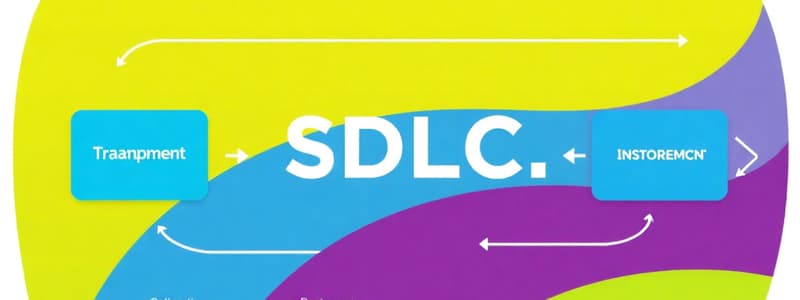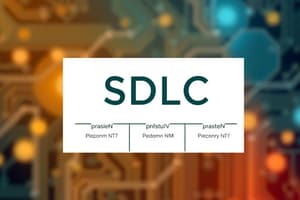Podcast
Questions and Answers
What is the first stage in the SDLC?
What is the first stage in the SDLC?
- Planning (correct)
- Testing
- Deployment
- Design and prototyping
What does SRS stand for?
What does SRS stand for?
- System Resource Specification
- Software Requirements Specification (correct)
- System Requirements Specification
- Software Resource Specification
What does the SRS report include?
What does the SRS report include?
- The scope of work (correct)
- The expected budget
- The client's contact information
- The team's resume
What are the two types of requirements discussed in the content?
What are the two types of requirements discussed in the content?
What is the primary goal of using the Software Development Lifecycle (SDLC)?
What is the primary goal of using the Software Development Lifecycle (SDLC)?
What do functional requirements define?
What do functional requirements define?
Which phase in the SDLC focuses on defining the problem and outlining the software's features?
Which phase in the SDLC focuses on defining the problem and outlining the software's features?
What is the role of a business analyst in the SDLC?
What is the role of a business analyst in the SDLC?
What do Non-functional requirements specify?
What do Non-functional requirements specify?
What is the purpose of a prototype in the SDLC?
What is the purpose of a prototype in the SDLC?
Which stage in the SDLC involves detailed discussions about outlined requirements?
Which stage in the SDLC involves detailed discussions about outlined requirements?
What is the role of the client in the SDLC?
What is the role of the client in the SDLC?
Which team member is responsible for ensuring the software meets the quality expectations?
Which team member is responsible for ensuring the software meets the quality expectations?
Which of the following is NOT a benefit of using the SDLC?
Which of the following is NOT a benefit of using the SDLC?
What is the function of the Operations and Maintenance phase in the SDLC?
What is the function of the Operations and Maintenance phase in the SDLC?
Which phase of the SDLC focuses on creating a detailed plan for developing the software?
Which phase of the SDLC focuses on creating a detailed plan for developing the software?
What is the purpose of the verification email sent to new users?
What is the purpose of the verification email sent to new users?
What is a key benefit of using abstraction in system design?
What is a key benefit of using abstraction in system design?
What is the main purpose of the testing phase in the Software Development Lifecycle (SDLC)?
What is the main purpose of the testing phase in the Software Development Lifecycle (SDLC)?
What is the primary purpose of the Detailed Design phase?
What is the primary purpose of the Detailed Design phase?
Which of the following is NOT a typical component of the SDLC?
Which of the following is NOT a typical component of the SDLC?
Which of these is considered a non-functional requirement?
Which of these is considered a non-functional requirement?
What is the key difference between System Design and Detailed Design?
What is the key difference between System Design and Detailed Design?
What is the main purpose of the Planning phase in the SDLC?
What is the main purpose of the Planning phase in the SDLC?
Which of these is NOT an advantage of the Waterfall model?
Which of these is NOT an advantage of the Waterfall model?
What is a key disadvantage of the Waterfall model?
What is a key disadvantage of the Waterfall model?
What benefit does the testing phase offer in software development?
What benefit does the testing phase offer in software development?
When choosing an SDLC model, what is a crucial factor?
When choosing an SDLC model, what is a crucial factor?
What is a primary characteristic of the Waterfall model?
What is a primary characteristic of the Waterfall model?
Which of these is NOT a typical phase in the SDLC?
Which of these is NOT a typical phase in the SDLC?
Why are SDLC Models important for software development?
Why are SDLC Models important for software development?
What is a key aspect of an Agile Model?
What is a key aspect of an Agile Model?
Flashcards
Verification Email
Verification Email
An email sent to users after registration to confirm their account.
Database
Database
A structured collection of data stored electronically, allowing for efficient access and management.
Concurrent Users
Concurrent Users
Users who access a web service or application at the same time.
Functional Requirements
Functional Requirements
Signup and view all the flashcards
Non-Functional Requirements
Non-Functional Requirements
Signup and view all the flashcards
Software Development Lifecycle (SDLC)
Software Development Lifecycle (SDLC)
Signup and view all the flashcards
System Design
System Design
Signup and view all the flashcards
Testing Phase
Testing Phase
Signup and view all the flashcards
Requirements Document
Requirements Document
Signup and view all the flashcards
Software Requirements Specification (SRS)
Software Requirements Specification (SRS)
Signup and view all the flashcards
Deployment
Deployment
Signup and view all the flashcards
Maintenance
Maintenance
Signup and view all the flashcards
Key Phases of SDLC
Key Phases of SDLC
Signup and view all the flashcards
Advantages of SDLC
Advantages of SDLC
Signup and view all the flashcards
Planning Phase
Planning Phase
Signup and view all the flashcards
Requirements Phase
Requirements Phase
Signup and view all the flashcards
Development Phase
Development Phase
Signup and view all the flashcards
Roles in SDLC Team
Roles in SDLC Team
Signup and view all the flashcards
SDLC Models
SDLC Models
Signup and view all the flashcards
Waterfall Model
Waterfall Model
Signup and view all the flashcards
Advantages of Waterfall Model
Advantages of Waterfall Model
Signup and view all the flashcards
Disadvantages of Waterfall Model
Disadvantages of Waterfall Model
Signup and view all the flashcards
Agile Model
Agile Model
Signup and view all the flashcards
Customer Requirements
Customer Requirements
Signup and view all the flashcards
Study Notes
Keywords
- Software: A set of instructions or programs that tell computers how to perform specific tasks.
- Software Development Life Cycle (SDLC): The process of developing software from an initial idea to a finished product.
- Server: A computer or program that provides data to other programs or computers.
Software Development Life Cycle (SDLC)
- Any software starts with an idea to solve a user problem.
- This idea goes through a defined process called SDLC.
- SDLC is a method that outlines the stages for producing high-quality software.
- There are seven key phases in SDLC.
Seven Phases of SDLC
- Planning: The initial brainstorming and groundwork.
- Requirements: Analyzing and documenting the needs of the software.
- Designing and Prototyping: Creating the blueprint and a model of the software.
- Software Development: Actual coding of the software.
- Testing: Ensuring that the software functions as intended.
- Deployment: Putting the software into use/into the market.
- Operations and Maintenance: Ongoing operational support and improvements.
Advantages of Using SDLC
- Creates high-quality software.
- Improves customer service.
- Increases employee productivity.
- Saves money.
Team Roles in SDLC
- Project Manager: Manages budget, resources, and timelines.
- Business Analyst: Understands business needs and technical requirements.
- Designers: Plan the design of the product and user interface.
- Developers: Write the software code.
- Operations: Sets up the hardware for the software.
- Testers: Validate that the software meets the required quality.
Requirement Analysis (SRS)
- Requirement Analysis: Involves a detailed discussion with stakeholders on the project requirements.
- SRS Report Outline: Includes sections for introduction, literature survey, functional and non-functional requirements, SDLC Model, feasibility study, system architecture, development, testing/results, and conclusions.
- Functional Requirements: Define how the system works and responds to inputs.
- Non-Functional Requirements: Define the system's quality, such as performance, scalability, security and usability.
Design and Prototyping
- The design phase analyzes the project's requirements and plans the product.
- Designers often develop multiple design approaches.
Design Phasese
- System Design: Identifying modules and/ or pages that make up the system.
- Detailed Design: Explains the logic associated with each module/page within the system.
System Design Methodology
- Designers can use abstraction methodology to break systems into smaller parts to better focus on one segment of the system at a time.
Software Development
- Developers write the code based on the project design.
- Designers continue to plan the user interface.
- Testers analyze requirements to create test cases.
Testing
- Testing validates the software's functionality and quality.
- Errors found during testing are corrected before launch.
- Testing helps in finding and avoiding software defects.
Operations and Maintenance
- Encompasses ongoing operations and support of the software to ensure continued functionality (and identify future improvements).
- Includes: Performance, Feedback, Maintenance
SDLC Models
- Different models can be used to complete a software project, with each model having their unique approach to the distinct phases of the SDLC.
- The choice of model depends on the customer's requirements and the timeline for project completion.
- Examples: Waterfall model, Agile model.
Waterfall Model
- Documents requirements upfront.
- Phases are completed sequentially.
- Simple for understanding.
- Suitable for projects with well-defined requirements.
- Not flexible in handling changes in requirements.
- Can be slow.
- Difficulty handling large-scale projects.
- Limited feedback availability.
Agile Model
- Adaptable to changing requirements.
- Iterative approach.
- Frequent feedback and testing.
- Suitable for large-scale projects.
- Requires extensive documentation (Agile methods support documentation but it is not usually a heavy part of an Agile project.)
- Potential for time overrun if not properly managed.
Studying That Suits You
Use AI to generate personalized quizzes and flashcards to suit your learning preferences.




